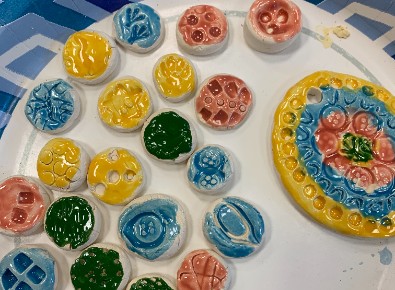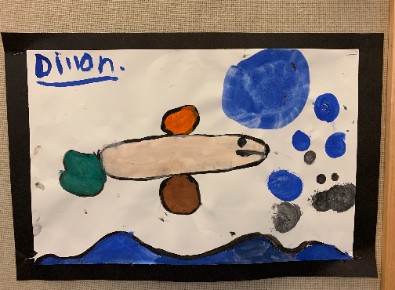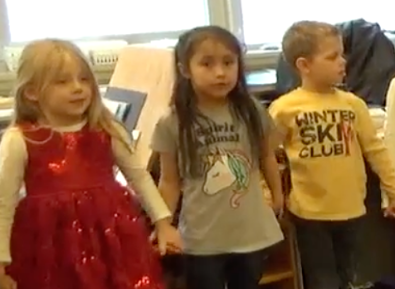Kindergarten Art Kits - Descriptions
Alaskan Animal Senses (Drama kit)
This drama lesson explores the basics of creative dramatic role-play and how different animals that live throughout Alaska use their senses to meet basic needs. By investigating animal activity through observation, imaginative movement and dramatic play, students will gain an understanding of the differences and similarities of animals in relationship to their environment, making connections to Alaskan ecology and biology. This lesson also provides an introduction to conventions of theatre as a performing art.
-mb432w.jpg)
Alaska Animal Masks
Students explore the unique facial features of different animals. They are introduced to paper sculpting techniques and create a mask of a local Alaskan animal, adding 3-dimensional features.

Children Just Like Me
Each child draws themselves and a favorite place or thing. The pictures are colored with colored pencils, then cut out to make a community class mural or border.

Clay Medallions and Counters
Students explore clay as a material. They create textures and patterns using common objects (provided in kit) and make a set of clay counters for the class to use for math games and a colorful (glazed) medallion for them to keep or give as a gift.

Color Critters
Students will listen to the story White Rabbit’s Color Book After some practice in mixing primary colored oil pastels in many combinations and discovering new colors, they will create a colorful critter from their practice sheet.
Drawing from Observation: Leaves
This is a foundational lesson in drawing from observation, getitng your students started with this way of seeing and recording. You will need to collect leaves for this lesson.-mxtex9.jpg)
Drawing from Observation: Push and Pull
Use the power of play, observation and drawing to help students build more knowledge of the phenomena of "push" and "pull."
Eat Like a Bear
In this art lesson, children learn about the many foods a bear eats, spring, summer and fall. Children's artwork helps them become more aware of primary colors, practice printing wtih objects, draw from observation, and bring the bear together with it's food in a mixed media project.
Formline Babies
Students are introduced to Northwest Coast Formline Design and the “ovoid” shape though Tlingit artist, Crystal Worl’s delightful series of “Formline Babies.” In this early childhood lesson, students learn some Tlingit phrases, go on a scavenger hunt in the room, and learn by painting and drawing on Crystal’s Raven and Eagle designs.

Learning to Paint our Ideas
Students collectively brainstorm their knowledge and ideas around a topic of the teachers choosing. They are taught painting techniques to help them paint clear and "easy to read" pictures that show their ideas on the topic. After introducing this painting technique through the kit, teachers can have students share their ideas through painting throughout the year on a variety of topics.
Marvelous Mittens
Students use mixed media to design a mitten for someone they know, making it both smart and useful as well as beautiful.

Me in the Mirror

Paint Color Mixing
Students use primary colors of tempera paint to mix and discover the magic of color mixing. They test their colors with other children in their table groups and their conversations are recorded on a poster created by the group.The Tlingit names for colors provide a foundation for students understanding of color and naming their own newly created colors.

Primary Paint: Shapes, Letters and Numbers
Students learn beginning paintbrush technique and practice using two sizes of paintbrushes with primary color tempera cakes. The art of American artist, Jasper Johns offers inspiration as student practice painting using shapes, numbers and letters as the subject matter.

Raven Puppets
Students learn about the significance of Raven in the Tlingit culture and learn the shape “ovoid”. Students “build” a 3-D raven puppet, using common shapes such as rectangle, square, triangle and rhombus. They will use techniques of cutting and folding paper.

Sea Creatures with Ray Troll

The Snowy Day at School
Students relate geometric shapes to the shapes of their school in a paper collage, then use paint to practice “printing” snowflakes, “painting” snow on the building, and making tracks in the snow with a bit of color mixing.
The beloved book, “The Snowy Day,” is included for inspiration.

Solstice Sun Collage

Stories with Scissors

Sunflowers

Tidepool Sculptures

Weather Stories (drama)
Weather Stories (drama)

The Wind and Me
The Wind and Me
In this integrated art lesson, students practice painting and drawing while feeling and hearing the wind. They are encouraged to observe the wind's effects on themselves and the world around them. In the Tlingit language: óoxjaa: wind; t’aakú: our local, strong, gusty wind.

"Yaakw" Canoes
"Yaakw" Canoes
Students learn about traditional NWCoast Native canoes. Given the opportunity to look at authentic carved canoe models, children draw pictures of the canoes and add colored rubbings of formline design to enhance the finished drawing.
